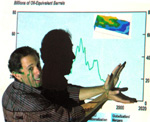The Risks at Buckman
 Jul 31, 2011 at 07:26AM
Jul 31, 2011 at 07:26AM Santa Fe recently brought online a new system that takes water out of the Rio Grande to supplement it's municipal drinking water. Unfortunately the new system, called the Buckman Direct Diversion, draws water from directly beneath several canyons that regularly dump storm water laced with radionuclides and other bomb-making contaminants.
What on earth would prompt Santa Fe officials to draw municipal drinking water from below the Los Alamos National Labs – host to more than 2,000 known toxic dumpsites? You might ask them. Seriously, call these members of the Buckman Diversion Board and ask what they were thinking:
Consuelo Bokum bokatz@cybermason.com 505-982-4342
Chris Calvert ccalvert@santafenm.gov 505-955-6812
Danny Mayfield dmayfield@santafecounty.org 505-986-6200
Rosemary Romero r2romero@santafenm.gov 505-690-3016
Liz Stefanics lstefanics@co.santa-fe.nm.us 505-986-6210
Virginia Vigil vvigil@co.santa-fe.nm.us 505-955-2755
Rebecca Wurzburger rebeccawurzburger@gmail.com 505-955-6815
They will tell you that they commissioned a study to look at the risk to Santa Fe residents, and (good news!) the study came back and said there was “no health risk” posed by drinking water from Buckman.
Here’s are a few things you should know about the Buckman and its risk to Santa Feans:
First, there is no such thing as “no risk.” Everything has risk, and when it comes to engineered systems, history is rife with examples of engineers under-predicting risk. I pointed this out in a letter to the Santa Fe New Mexican last November, and surprisingly I got a call the next day from an investigator from the New Mexico Board of Registration for Professional Engineers. He reminded me that when I became licensed as an engineer in New Mexico, I agreed to abide by a Code of Professional Conduct that includes reporting substandard engineering practice that might effect public safety. So I filed a formal complaint against ChemRisk – the company that did the risk analysis. The investigator, Roman Garcia, told me that no ChemRisk employees could be found on the roles of licensed engineers in New Mexico.
It’s one thing to practice engineering without a license, and it’s another to tell 100,000 users of a water system that there is no health risk from drinking water taken from beneath a nuclear waste dump.
The results of ChemRisk’s report were released in draft form in October, 2010 after Santa Fe had already spent more than $200 million on the Buckman project. ChemRisk charged $200,000 for the analysis -- about one-tenth of one percent of the project cost. Seems to me it would have been a good idea to determine the risk ahead of the project, rather than after it’s completion. But wait, there’s more!
On it’s website, ChemRisk bills itself as the “premier contractor in the U.S for characterizing former nuclear weapons complex sites.” In other words, they have carried out millions of dollars worth of work on behalf of LANL and other weapons complexes. Are they willing to jeopardize those contracts in favor of a little $200,000 contract for Santa Fe? It’s what you might call an “inherent conflict of interest”.
ChemRisk’s integrity has been questioned before. In 1997, the Wall Street Journal reported that ChemRisk “reanalyzed” data from another scientist and published a story in a scientific journal, under the original scientist’s byline, reversing his conclusion that chromium contamination in drinking water leads to an increased risk of stomach cancer. ChemRisk didn’t mention that their work was paid for by PG&E, who was working at the time on the infamous Erin Brockovich case. PG&E paid $333 million to settle the case, and the scientific journal retracted the article.
Did ChemRisk’s do anything unethical when they analyzed the Buckman data? In my opinion, they did. Buried in the report is an assumption that four of the most dangerous contaminants known to wash into the Rio Grande above Buckman are removed before anyone drinks the water. In other words, they analyzed the risk of contamination after the contaminants were removed, allowing them to state that there is “no health risk”.
Just about anyone can tell you that after you remove contaminants, there is no risk of contamination. You don’t need to spend $200,000 to find that out. But the media, and no doubt the public, didn’t pick up on this point. All that was reported, and all that was heard, was the part about “no risk”.
I haven’t carried out my own analysis of the risk of LANL contamination getting into Santa Fe’s drinking water and making people sick, but common wisdom tells me that it’s around 100 percent. My reasoning is this: If you put one bullet in a six-shooter, spin the cylinder, point the barrel at your head and pull the trigger, the odds of killing yourself are just one in six. But it is a well established fact that if you repeat the game over and over again, hour after hour, day after day, you will surely kill yourself. The Buckman system is slated to be used for many, many years, and LANL contaminants aren’t going away anytime soon.
In fact, if they get their new $6 billion weapons factory, the contamination up there will only get worse.
My complaint to the engineering board has yet to be acted upon, nearly nine months later, and as far as I know, Santa Feans are still drinking the water.
Who signed us up for this game of Russian Roulette anyway?







